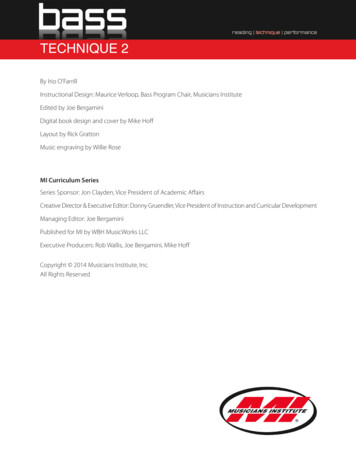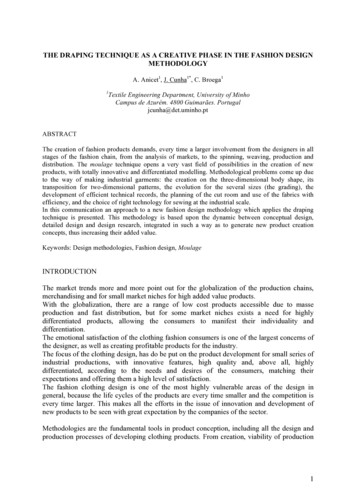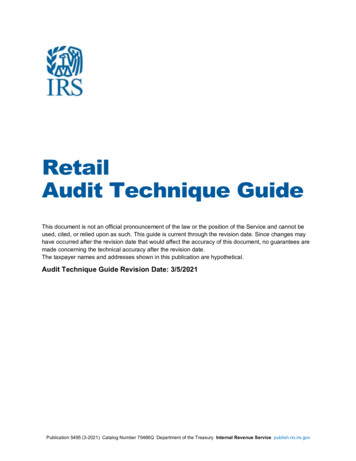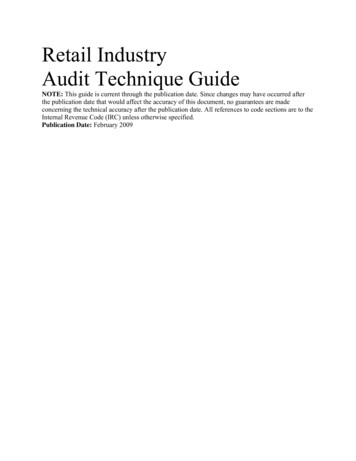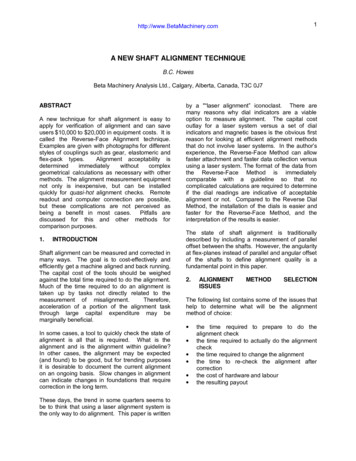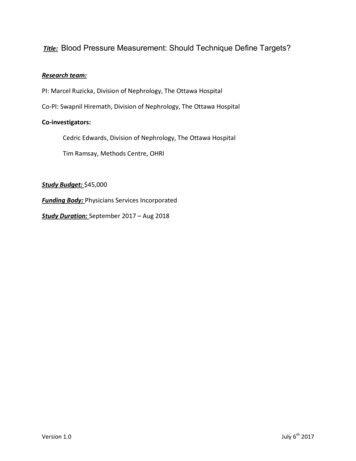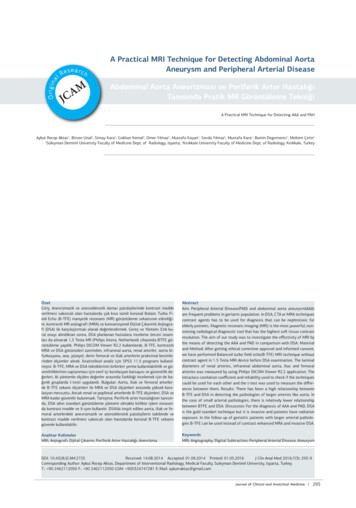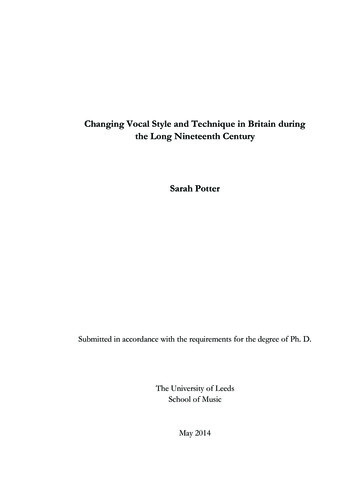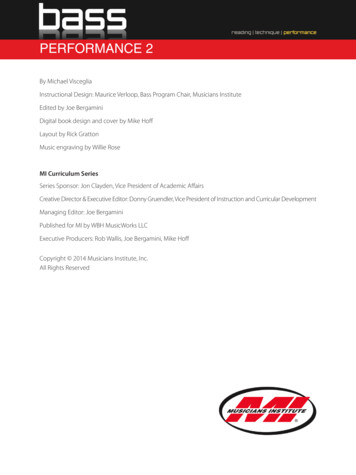
Transcription
reading technique performancePERFORMANCE 2By Michael ViscegliaInstructional Design: Maurice Verloop, Bass Program Chair, Musicians InstituteEdited by Joe BergaminiDigital book design and cover by Mike HoffLayout by Rick GrattonMusic engraving by Willie RoseMI Curriculum SeriesSeries Sponsor: Jon Clayden, Vice President of Academic AffairsCreative Director & Executive Editor: Donny Gruendler, Vice President of Instruction and Curricular DevelopmentManaging Editor: Joe BergaminiPublished for MI by WBH MusicWorks LLCExecutive Producers: Rob Wallis, Joe Bergamini, Mike HoffCopyright 2014 Musicians Institute, Inc.All Rights Reserved
BASS PERFORMANCE 2Unit 1Introduction1.Applied Cross-String Rhythms2.Changing Positions3.The Hard Rock Shuffle4.Basic Notation, Structure and Concepts5.Hard Rock Shuffle Play-AlongUnit 21.A Closer Look at Time Signatures2.Dotted Notes3.Finding the Missing Note or Rest Value4.Performance Notes and Sound5.Basic Notation, Structure and Concepts6.Country-Pop Play-AlongUnit 31.The Phonics of Counting Beats2.Introduction to Latin Music3.Basic Notation, Structure and Concepts4.Bossa Nova Play-AlongsUnit 41.Circle of Fifths, Major and Relative Minor Keys2.The Natural Minor Scale3.Basic Notation, Structure and Concepts4.16th-Note Grunge Rock Play-AlongUnit 51.Stax and Motown2.Elements of the R&B Style3.Basic Notation, Structure and Concepts4.Stax/Motown 447
Unit 61.Jazz and the Walking Bass Line2.Elements of the Walking Bass Style3.Four Notes to the Bar4.Leading Tones5.Performance Notes and Sound6.Jazz Play-Along ChartsUnit 71.Reggae Bass2.Ostinato3.Basic Notation, Structure and Concepts4.Performance Notes and Sound5.Reggae Play-AlongUnit 81.The Origin of Slap Bass2.Basic Execution and Sound3.Basic Notation, Structure and Concepts4.Slap Bass Play-AlongsUnit 91.Slap Bass: Let’s Get Busy!2.Practice Modules3.Basic Notation, Structure and Concepts4.Performance ChartsUnit 101.Funk Rock/Funk Metal2.Basic Notation, Structure and Concepts3.Funk-Metal Play-AlongAbout the 883
reading technique performanceIntroductionWelcome to book two of the Bass Performance course at Musicians Institute. The course work that we willbe covering over the next ten units will put you well on your way toward acquiring the knowledge andskills that every professional bass player possesses, while furthering your mastery of the instrument. In orderto be a professional bassist, you must attain employment as one, and the diligent practice of the materialcovered in this book and in books three and four will enhance that career goal.In book one we covered basic concepts such as getting a good sound, being attentive and prepared for yourclasses and gigs, introductions to various musical styles (with accompanying performance exercises), basicreading skills from whole notes through 16th notes (and their accompanying rests), basic concepts ofgrooves from rock to country, from singer-songwriter to funk, and shuffles. We also covered chart navigationwith different endings and signifiers, such as da capo, del segno, coda, fine, and single-bar and multiple-barrepeats. If you are unsure of any of these topics, please refer to book one for clarification and review.4 Bass Performance 2
Unit 1 - Chapter 1Repeat SignsChapter1: Applied Cross-String RhythmsEx. 1.5Up until now, the performance exercises that you have been given have primarily been linear, or movingfrom string to string. One of the more challenging techniques in playing the bass guitar involves playingacross the strings, or bass lines that skip over strings, in order to play wider intervals. The successful executionof this movement involves the concerted coordination and strengthening of both hands, and theappropriate exercises will be provided in order to accomplish this.One of the main things to be aware of when playing music that requires string-crossing is to control thestring that’s not being played. It is very common for beginner players to overlook this important aspect ofthis technique. This results in unintentional ringing or vibrating of the unwanted string—and that willinterfere with a clean performance of the music. The responsibility of controlling the unwanted sound incross-string playing falls on the left hand. The goal here is to have part the left hand gently mute the string(s)that isn’t being played. You’ll notice that the left hand has a natural tendency to do this, as the fingers curlaround the strings.Another challenge to playing cross-string bass lines is to make up for the lack of strength in the left-handpinky finger by using it in conjunction with the ring finger. This harkens back to upright bass left-handtechnique, where the left-hand ring finger acts as a support to the fourth finger. Playing with the third andfourth finger of the left hand together will make it much easier to play wide intervals and octaves acrossstrings. The performance piece that you will be working on later in this unit will be a steady execution ofeighth notes. As with any piece of music that doesn’t contain a lot of rests, this can be very demanding.Constant playing of cross strings with precision can stress the left hand. It’s advisable to keep your left handas relaxed as possible, and to apply pressure to the notes when needed. Keeping your left hand very tightand stressed can sometimes lead to overuse syndromes such as tendonitis. If you feel any unwarrantedpain, take a break. Keeping both your playing hands relaxed will help to stave off any of the commonneuromuscular ailments.When playing cross-string rhythms, the suggested approach is to anchor your plucking hand by the thumbat any point that feels comfortable and secure, although the floating-hand technique works just as well, ifthat’s what you’re accustomed to. Anchoring is usually done on a thumb rest, the top of a pickup, the lowstring (when it is not being played), or even on the body of the bass itself. This secure perch will allow youto pivot from the wrist and attack the correct string while playing over the unintended string. When doingthis, it is critical to make sure that the notes are attacked evenly by the alternating first and second fingersof the right hand. The goal, as always is controlled dynamics and evenness in sound!5
Chapter 2: Changing PositionsDe-Tuning the Low E StringMore often than not when playing cross-string bass lines, you will move from position to position as themusic demands. At this point in your development, the easiest way to approach this is by leading to the newposition with the first finger of the left hand. This will preserve your form and give you an economy ofmovement from one position to the next. By doing this consistently you will start to recognize bass patternsand intervallic relationships more readily, since the regularity of the bass’s tuning and its associated intervalsprovides continuity throughout the neck.It’s not uncommon in rock music that the guitar and/or bass will tune down the low E string in order to makethe music sound heavier and add low sonics to the harmony. Of course, this applies only to four stringbasses where the low string is the traditional E. Getting a low D or even a low C# from the E string hasbecome such a common occurrence that there are low E de-tuners that can replace the tuning machine onyour E string. These can be calibrated to lower the E by a half step, whole step, or more with a flip of the leverthat’s attached to the tuning peg. But if you are going to do this with regularity, be aware of the gauge ofthe low E string: the lower you tune down, the more possibility of fret noise there will be—as the string willbecome more slack. In such a case, you might want to switch to a heavier gauge string or even adjust yourattack to minimize any extraneous fret noise. Note that when you tune down a whole step, you must adjustyour fingering by two frets to compensate. Thus, the root note now falls on the same fret as the octavegoing from the fourth string to the second string.This song can be executed in regular tuning if so desired. If the player prefers this, then play the Dmi barsan octave higher than written. The objective of this unit is to execute cross string bass lines, and this willhappen regardless of what octave these notes are played in. Drop D tuning will be expanded upon, brokendown and exercised in Technique 3 as well as Performance 3.Ex. 1.1 E tuned down to DEx. 1.26 Bass Performance 2
Unit 1 - Chapter 3Chapter 3: The Hard Rock ShuffleAs we learned in Bass Performance 1, the shuffle feel is a tried-and-true groove that has found its way toevery genre of music, from the blues and jazz to country and even hard rock. Bands like Led Zeppelin, DeepPurple, Smashing Pumpkins and ZZ Top have incorporated this feel into their music. As with all hard rock,the key to a hard rock shuffle is the intensity with which one needs to play while maintaining your focus oncontrolling the instrument. This gets harder to do at louder volumes, as every minute touch of the bass andfingering of strings is extremely amplified. The more experience you have playing at louder volumes, theeasier it will be to control the instrument. But here’s the important thing to remember: Never play at avolume that prevents you from hearing the other musicians that you’re playing with, especially thedrummer ! The key to playing successfully in a hard rock setting is to always mix yourself into the on-stagesound and let the house sound engineer do the rest. The front-of-house soundman has the control to makeyour sound as powerful as it needs to be (and should be) in hard rock music. Playing too loudly on stage willremove that power and limit your chances of a successful mix. All too often, amateur musicians have theirstage volume so loud that it becomes impossible for either the player or the listener to discern anythingthat’s being performed. If you can’t hear your bandmates clearly on stage, consider it a signal for all to payattention to the volume.Ex. 1.37
Chapter 4: Basic Notation, Structure and ConceptsWe will continue to reinforce the assimilation of sections of songs, accentuating the groupings of bars thatcomprise each section, whatever the number. Performance example 1.9 has a shuffle feel as the groove’sfoundation, with the quarter note at 128 BPM. Please refer to Bass Performance 1 for comments aboutstamina and execution. Another interesting thing about this next piece is the odd groupings of measuresfor each section. Since the bass line doesn’t veer much away from eighth notes played in octaves, the taskhere is to distinguish the sections through increasing familiarity with the melody. Since there isn’t the usualsymmetry that we hear in pop songs, this may take several practice attempts, so please count your measuresas you read through the exercise.The performance chart has an eight-bar intro.Ex. 1.4The eight-bar A section is repeated with first and second endings.Ex. 1.58 Bass Performance 2
Unit 1 - Chapter 4Then there is an 18-bar B section with a D.S. to the A section, where you take the second ending only.Ex. 1.69
Then the chart goes into a ten-bar C section.Ex. 1.7Finally, there is a 16-bar D section, where we end with a tied note on the upbeat of 4 of the 16th measureinto a whole note and what could be considered as the 17th and final measure of the D section—andthe song.Ex. 1.810 Bass Performance 2
Slap Bass: Let’s Get Busy! 73 2. Practice Modules 74 3. Basic Notation, Structure and Concepts 75 4. Performance Charts 78 Unit 10 1. Funk Rock/Funk Metal 81 2. Basic Notation, Structure and Concepts 82 3. Funk-Metal Play-Along 85 About the Author 88 . Welcome to book two of the Bass Performance course at Musicians Institute. The course work that we will be covering over the next ten units .
